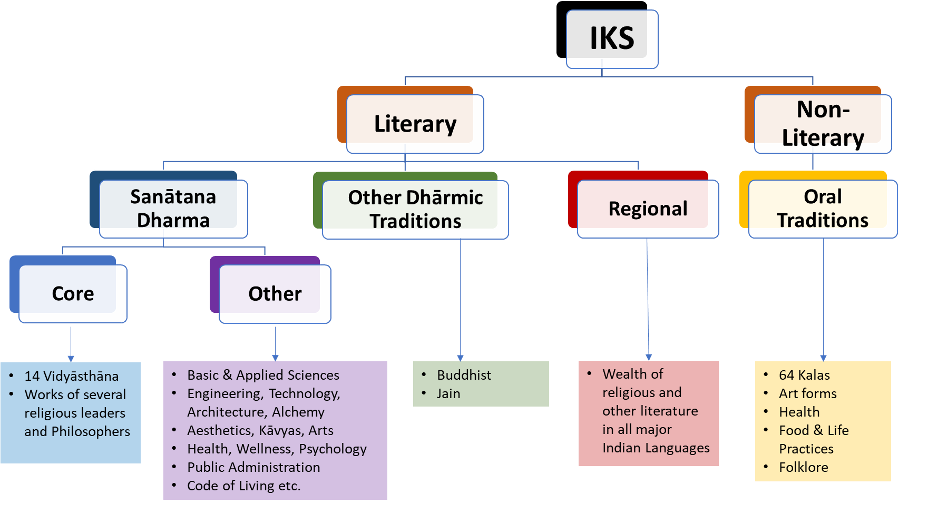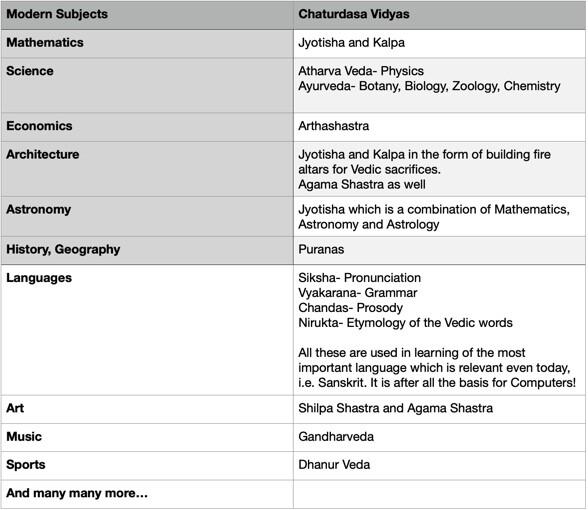Indian Knowledge System Corpus - A classification framework
The IKS Corpus - A Classification Framework

I. Broad Divisions of the IKS Corpus
-
Literary Part:
- Texts and written knowledge.
- Further divided into:
- Sanatana Dharma Corpus
- Other Dharmik Literature (Buddhism, Jainism)
-
Non-Literary Part:
- Oral traditions and unwritten knowledge.
- Includes health traditions, art forms (64 Kalas), and more.
II. The Literary Part: Sanatana Dharma Corpus
A. Core Scriptures:
-
Vedas and Vedangas:
- Fundamental building blocks of Sanatana Dharma.
- Basic core texts
B. Other Sanatana Dharma literature:
- Aligned to the principles of Sanatana Dharma.
- Includes fields such as:
- Mathematics
- Astronomy
- Aesthetics
- Engineering and Technology
-
Example: Mathematics in Astronomy aligning to Yuga cycles from Sanatana Dharma.
- Mostly in Sanskrit.
- Regional Languages often retell or contextualize ideas from Sanskrit texts.
III. The Literary Part: Other Dharmik Literature
-
Key Elements: Buddhist and Jain literature.
-
Significant Contributions: Includes contributions on Mathematics and other fields.
-
Historical Context: Contributions date back to 500 BCE and later.
A. Buddhist Literature:
* Includes mathematical concepts.
* Covers maritime activity, shipbuilding, and alchemy.
* Example: Nagarjuna's *Rasaratnakara* (1st century CE) - early alchemy work.
B. Jain Literature:
* Has canonical sacred texts.
* Mathematics is an integral part of the literature (*Ganitanuyoga*).
* Example: Attempts to determine number of species (2^96), mathematical texts like *Tattvartha Sutra*, and works by mathematician Madavacharya.
IV. The Non-Literary Part
-
Oral Traditions:
- Health traditions.
- Art forms (including the 64 Kalas).
- Many other types.
V. Sanatana Dharma - Other Literature (Basic and Applied Sciences)
-
Basic and Applied Sciences:
- Mathematics
- Astronomy
- Plant Sciences (Vriksha Ayurveda)
- Engineering & Technology
- Metal working
- Shipbuilding
- Dams and watershed management
- Alchemy
- Cosmetics, perfumes, dyes, town planning, and architecture
- Health, wellness and psychology
- Ayurveda, including Charaka Samhita, Sushruta Samhita, Ashtanga Hridaya
- Philosophical systems (Yoga, Sankya, Upanishads, Vedanta etc.) also talk about Psychology
-
Niti-sastras:
- Code of conduct for society
-
Raja-niti (public administration & governance) and Samanya-niti (ethics, morality)
- Aesthetics, Kavyas and Performing arts.
VI. Caturdasa Vidyasthana - Core Sanatana Literature Classification (14 Parts)

-
4 Vedas and Upavedas (Core Texts)
-
6 Vedangas (Auxiliary texts to Vedas)
-
Puranas
-
Itihasas
-
Dharma Sutras, Sastras and Smrtis (Law, Ethics)
-
Nyaya (Detailed Logic)
-
Mimamsa (Purva and Uttara Mimamsa - Philosophical Texts)
Comparison with Modern Systems
-
Vedas are the core texts - equivalent of the Bare Act (e.g., Income Tax Act).
-
Smrtis and Dharma Sastras (and their commentaries) are the guides - equivalent to Guide to the Act, providing details on how to apply the core texts.
-
Puranas and Itihasas are equivalent to Case Laws, which explain real-life applications and outcomes of the core texts.
VII. Conclusion
- The classification schemes of the IKS corpus are quite interesting and comparable to the methods we use today.


